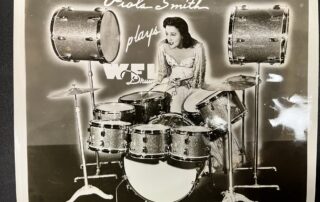Buddy Holly is a rock ‘n’ roll legend. In the 1950s, he became a musical torchbearer, helping popularize the genre with his band, The Crickets. They had big hits with songs like “That’ll Be The Day” and “Peggy Sue.”
According to “Rolling Stone,” Holly was a massive influence on musicians like Bob Dylan and Bruce Springsteen. He helped shape the sound of bands like The Rolling Stones and The Beatles, who covered his songs like “Words of Love.”
Holly’s life was cut short following a plane crash on “The Day the Music Died,” along with tour mates Ritchie Valens and J.P. “The Big Bopper” Richardson. Just two days before that, his second to last show was in Green Bay, Wisconsin at the Riverside Ballroom. Author and Buddy Holly fan Dean Robbins reflects back on that fateful tour, which included a number of stops in Wisconsin.
==

A Winter Dance Party concert at the Riverside Ballroom in Green Bay, Wisconsin on February 1, 1959. This poster sold at an auction on November 19, 2023. (Courtesy of Heritage Auctions)
Buddy Holly’s death is usually associated with Clear Lake, Iowa. That’s where he played his final rock ‘n’ roll show on February 2nd, 1959. Buddy was headlining a tour called The Winter Dance Party. It began in Milwaukee’s Million Dollar Ballroom and included stops in Appleton, Green Bay, and Kenosha, along with small towns in Iowa and Minnesota.
A callous booking agent scheduled the dates haphazardly. The musicians had to travel hundreds of miles on unreliable busses. Then, there was a blizzard.
One night, their bus died on the way to Appleton, stranding them on a deserted highway in -30 temperatures. They had to set fire to newspapers to stay warm.
A couple days later on the road from Green Bay to Clear Lake, Buddy had his brainstorm. He would charter a plane for a hassle-free trip to the next gig for himself and tour mates Ritchie Valens and The Big Bopper. They all went down together in a snowstorm, a tragedy known as “The Day the Music Died.”
Whenever it turns to winter in Wisconsin, I fantasize about seeing one of Buddy’s last shows here in 1959. He played “Peggy Sue,” “That’ll Be the Day” and other irrepressible songs that set the style for early rock n’ roll.
No matter how gloomy I feel when I think about Buddy’s shortened career, I can’t help but smile when I hear this profoundly simple music. With his elastic vocals and ecstatic guitar, Buddy embodied the hopeful, joyful, youthful rock n’ roll spirit that shook up the record industry in the late 1950s.
I also fantasize about meeting Buddy after one of his Wisconsin shows. Back then, rock stars didn’t hide behind their security guards. I imagined telling him how happy his songs make me feel, and then offering to drive him to the next date in my car, so he doesn’t have to travel on unreliable busses or planes.
Of course, I can only fantasize for so long before a cold, hard reality returns. Buddy did charter that plane. He died at 22, never knowing that he influenced the Beatles and the Rolling Stones and changed the course of music history. My gloom starts to set in again. luckily, there’s a sure cure for gloominess in this world. It’s Buddy Holly’s music.
(This story originally aired on February 17, 2012.)











